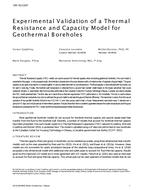Description
Thermal Resistance Capacity (TRC) models are used to account for thermal capacity when simulating geothermal boreholes. One such model ispresented in this paper. In the proposed model, the borehole is discretized in the axial direction with a limited number of segments of equal height. The groutcapacity at any given cross-section is lumped together in various nodes each with its own temperature. The fluid capacity is also included with two nodes, onefor each U-tube leg. Finally, the borehole wall temperature is obtained from a ground heat transfer model based on the classic cylindrical heat sourceanalytical solution. Experimental data from two tests performed at the Canadian Centre for Housing Technology (Ottawa, Canada) are used to validatethe TRC model presented here. The first data set is taken from a thermal response test (TRT) performed on a 76 m borehole. This test is used to obtainthe ground thermal conductivity but also to calibrate the ground model to estimate the ground thermal diffusivity. The second set is taken from the actualoperation of two parallel boreholes linked to two 3.52 kW (1 ton) heat pumps used to heat a house. Measurements were taken every 5 minutes over aperiod of 47 days and include periods of intermittent operation. Results show that there is excellent agreement between the outlet temperatures and the grouttemperatures predicted by the TRC model and the corresponding experimental temperatures.
Citation: 2016 Winter Conference, Orlando, FL, Conference Papers
Product Details
- Published:
- 2016
- Number of Pages:
- 8
- Units of Measure:
- Dual
- File Size:
- 1 file , 700 KB
- Product Code(s):
- D-OR-16-C047




